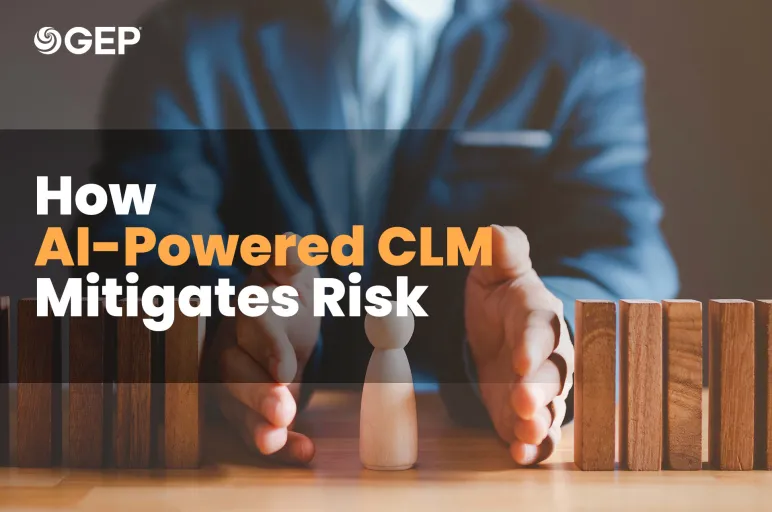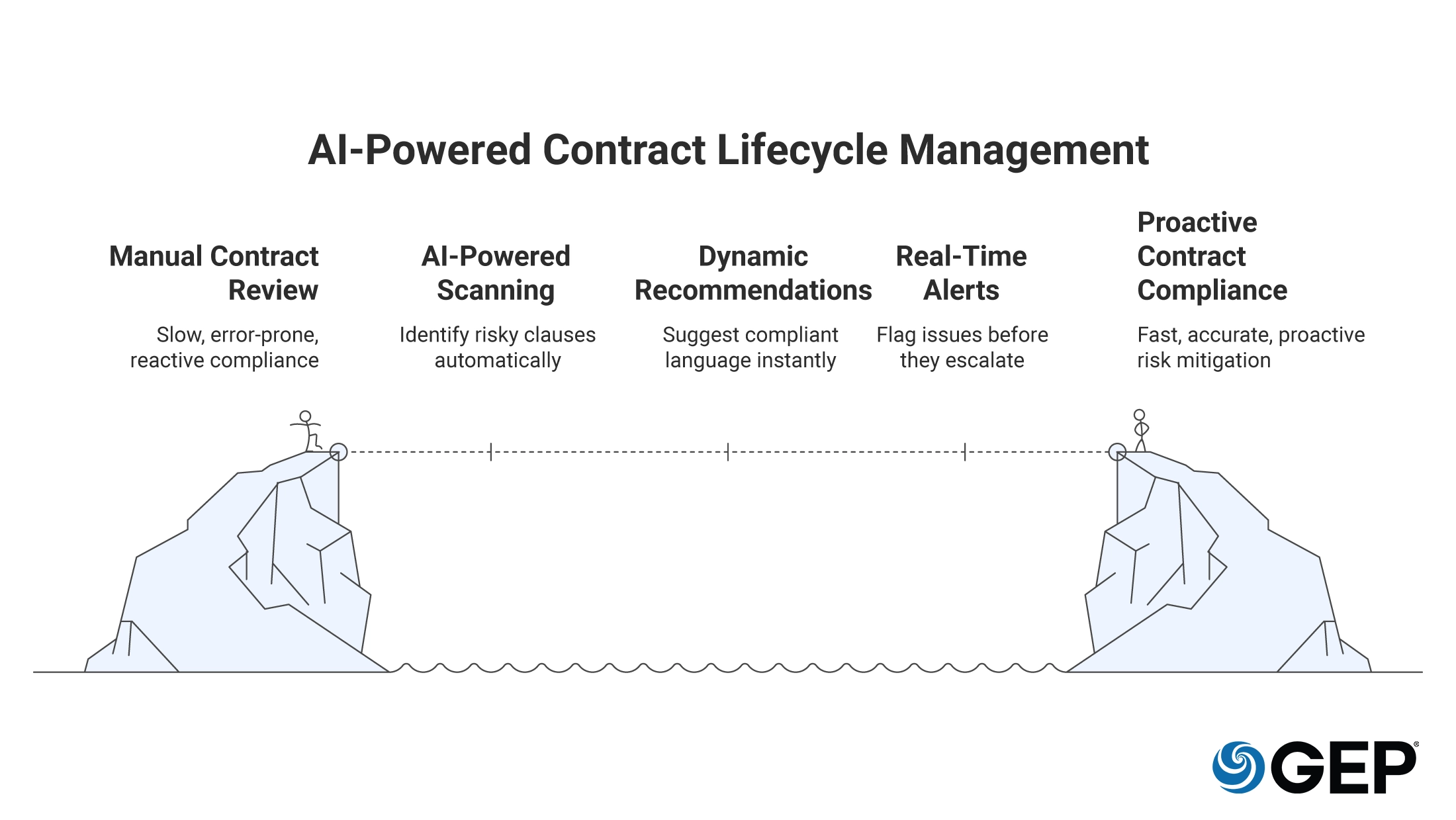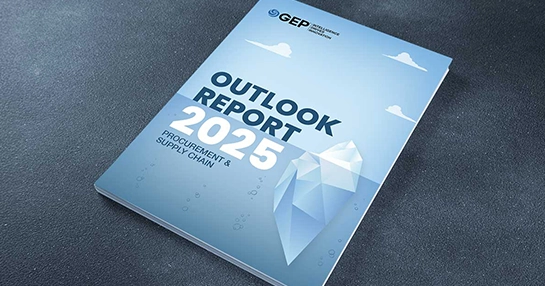
How AI is Transforming Risk and Compliance in Contract Lifecycle Management
- AI in CLM is helping procurement teams stay ahead of risk by keeping contracts in line with GDPR, ESG goals and other global rules.
- Smart contract review tools can uncover liabilities, suggest safer terms and warn of problems before they cost money.
- Leaders who bring AI into CLM gain speed, sharper insights and less exposure to compliance failures.
October 29, 2025 | Contract Management 4 minutes read
Procurement’s New Armor in the Age of Global Risk
Risk isn’t hidden in the fine print anymore. It’s there in every supplier agreement, every data clause, every click to approve a contract.
Regulations like GDPR and the EU’s CSRD can change quickly, and industry frameworks can shift just as fast. Old approaches to contract lifecycle management simply weren’t designed for that pace.
That’s where newer CLM platforms come in. Today’s intelligent CLM platforms are your compliance watchdogs, scanning, interpreting and advising on every legal nuance across your contract portfolio to improve compliance and mitigate supplier risk. Powered by AI, they read through contracts, surface issues and point out compliance gaps. Instead of being surprised later, procurement teams can deal with problems before they grow.
Risk Has Changed. Has Your CLM?
Every contract has some risk baked in. The challenge is that in global procurement, even “standard” language can be dangerous. A single vague phrase on data use could be a GDPR breach. Skipping a sustainability clause could lower ESG scores. A supplier deal drawn up under one country’s law might not hold in another.
For years, procurement leaned on manual reviews and long checklists. That approach struggles in a world of global supply chains, fast regulatory changes and pressure to close deals faster. AI isn’t just about speed. It’s about reading context, interpreting intent and flagging the things humans may overlook.
AI Sees What Humans Miss
Modern CLM platforms use AI to read entire contract libraries at once. They pick out clauses that don’t match your standards, terms that introduce risk, and gaps tied to industry or geography.
Take GDPR. An AI-powered CLM platform can scan a contract, find where consent language is missing and even suggest an updated clause that meets the latest rules. No need to send every contract to legal for routine fixes.
On the ESG side, AI can identify contracts that don’t mention sustainability or supplier diversity. If new carbon rules come into effect, the system can highlight every agreement that falls short. Procurement gets a radar screen for risks, instead of waiting for an audit to reveal them.
Dynamic Clause Recommendations, Tailored to Compliance
One of the most practical features of AI-powered CLM is dynamic clause guidance. Instead of sifting through a playbook, these systems use natural language processing to suggest the right wording based on the contract’s context.
Imagine you’re negotiating a software deal in Europe. The AI knows data residency is an issue, so it recommends a GDPR-compliant clause that fits that specific contract. If third-party sub-processors or cross-border transfers are involved, it adjusts automatically.
This takes the guesswork out of compliance. Teams don’t have to remember every nuance or keep track of shifting templates. The right protections are built into the deal as it’s written.
Proactive Alerts and Risk Scoring
Intelligent CLM platforms also push out alerts when something is off. A high-risk clause, a missing compliance requirement or a term that breaks company policy will trigger a notification. Each alert explains why it matters and how serious it is.
You might get a notice that a supplier agreement doesn’t include the human rights language your ESG policy requires. Or that a renewal has payment terms banned by new laws in one of your markets. Better to catch it then than during an audit or dispute.
On top of that, risk scoring gives every contract a rating. It weighs compliance gaps, financial exposure, and third-party risks. Leaders can focus their legal resources on the riskiest contracts instead of treating every agreement the same.
Control Risk at the Clause Level
Use AI in CLM to surface threats, ensure compliance and boost ROI
Global Compliance Without Global Legal Teams
Procurement groups now deal with contracts across dozens of regions, from European privacy law to U.S. trade restrictions to new ESG rules in Asia. Few companies can afford legal specialists in every jurisdiction. AI fills that gap.
The leading CLM systems constantly update with new rulings and regulations. If the EU changes data transfer rules, or a U.S. state passes stricter ESG reporting requirements, the platform updates its recommendations. It’s like having a global legal analyst sitting in on every negotiation.
This matters most for companies with wide supplier networks. A single noncompliant vendor agreement can create regulatory headaches and damage reputation. AI helps make sure each partner contract lines up with your compliance standards.
Speed Meets Governance
In the past, compliance slowed procurement down. Legal reviews dragged, and governance often clashed with agility. With AI, you don’t have to choose between the two.
Intelligent CLM automates routine reviews. Clause suggestions keep negotiations moving. Approvals speed up, but oversight is still built in. Every change is tracked, so governance isn’t lost in the rush.
The impact is clear: faster contract cycles, fewer roadblocks and healthier supplier relationships. The problems that once took weeks to resolve can now be prevented up front.
Procurement’s Strategic Future Starts With Smarter CLM
Regulation is tightening everywhere, and procurement’s role in managing compliance is bigger than ever. Manual reviews and patchwork oversight can’t keep pace.
AI-enabled CLM turns contracts into live documents — searchable, analyzable, and governed in real time. Procurement leaders get visibility, control, and the ability to manage risk before it hits.
For organizations that take the leap, AI acts as a shield, protecting your business’s contracts and its reputation.
Discover More: Contract Management Software Solutions




